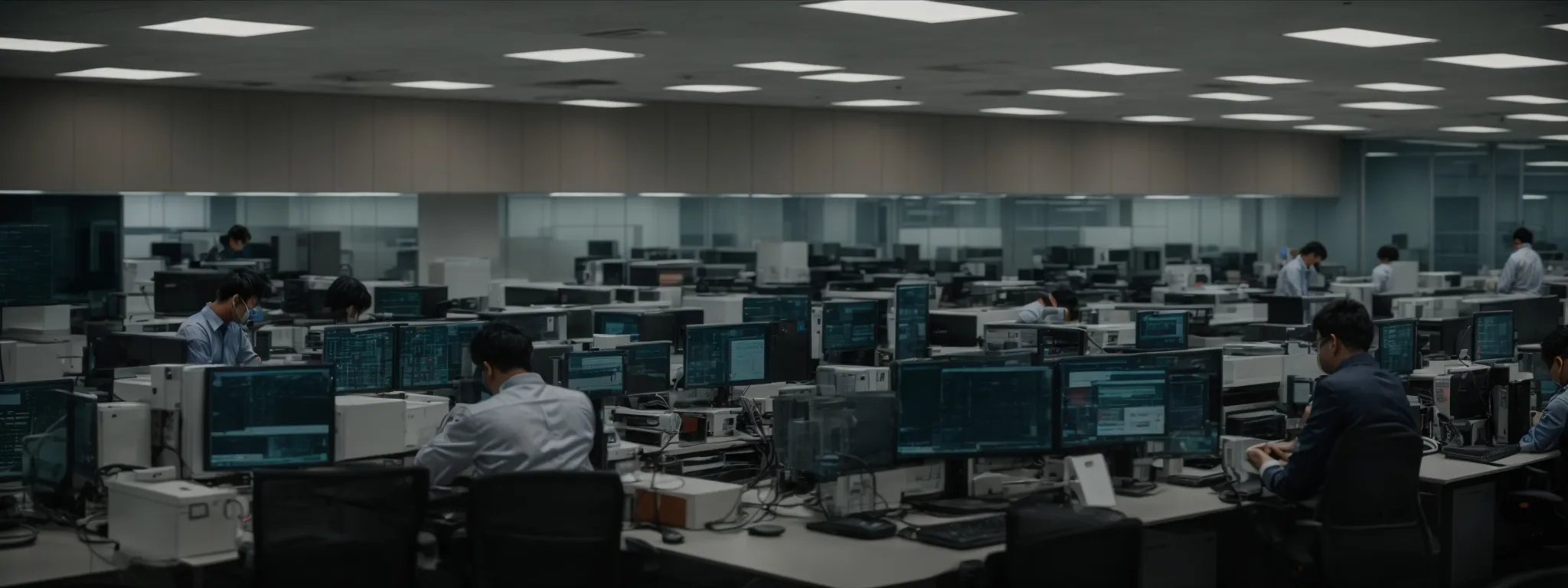Enterprise vs. SaaS Software
Understanding the Differences: Enterprise Software Versus SaaS Solutions In the dynamic landscape of digital solutions, businesses often find themselves at a crossroads when deciding between traditional enterprise […]
Understanding the Differences: Enterprise Software Versus SaaS Solutions
In the dynamic landscape of digital solutions, businesses often find themselves at a crossroads when deciding between traditional enterprise software and modern Software as a Service (SaaS) solutions.
Each choice comes with distinctive features, from the complexity of deployment to the nuances of data control and security.
With the evolving needs of companies and the shift towards cloud computing, understanding the intricacies of these two models is critical for informed decision-making.
Keep reading to dissect the pivotal differences and determine which service best aligns with your organization’s goals and operations.
Key Takeaways
- Enterprise Software Offers Deep Customization and Control for Organizations With Complex Needs
- SaaS Solutions Provide Flexibility, Scalability, and Ease of Upgrades Through Cloud Computing
- Choosing Between Enterprise Software and SaaS Depends on Factors Like Cost, Scalability, and Control
- Data Security and Compliance Are Critical Considerations in Both Enterprise and SaaS Platforms
- The Support Structure for Enterprise Software Is More Tailored, Whereas SaaS Offers Standardized, Efficient Support
Defining Enterprise Software and Its Scope

In the realm of modern business technology, understanding the nuances between enterprise software and Software as a Service (SaaS) solutions is critical for corporations looking to optimize their operational efficiency.
Enterprise software encompasses a broad spectrum of applications designed to satisfy the complex, multifaceted needs of large organizations.
This software supports a variety of business functions including resource management, supply chain operations, human resources, and data warehousing, among others.
As we clarify what constitutes enterprise software, we will also delve into how its extensive capabilities can be leveraged to streamline processes, Enhance Data Security, and drive intelligent decision-making within an enterprise.
Clarifying What Constitutes Enterprise Software
Enterprise software is a category of computer applications crafted to meet the expansive requirements of large businesses and organizations. These applications are integral to enabling effective management of various facets of an organization’s operations, from strategic planning and project execution to customer relations and business intelligence.
Such software stands apart through its capacity for scalability and its ability to integrate with existing IT infrastructures and databases. The essence of enterprise software is its power to facilitate complex, large-scale processes, equipping corporations with the tools necessary to maintain a competitive edge in their respective markets.
Exploring the Full Range of Enterprise Software Capabilities
Within the expansive terrain of enterprise software, the capabilities extend into the realms of project management software, accounting software, and customer relationship management systems. These solutions cater to the pivotal demands of resource planning and coordination, financial oversight, and maintaining fruitful customer interactions.
Enterprise resource planning systems are notable for their multifunctional approach, integrating various operational processes such as supply chain management, payroll, and human resource management into a harmonious framework. Enterprises harness these systems to craft a synchronized infrastructure that accelerates productivity and fortifies their strategic position in the marketplace.
| Enterprise Software Function | Key Benefits |
|---|---|
| Project Management | Streamlined execution and oversight of strategic initiatives |
| Accounting | Consolidated financial management with enhanced compliance |
| Customer Relationship Management | Improved customer engagement and retention |
| Supply Chain Management | Agile, efficient, and transparent supply chain operations |
| Human Resources Management | Comprehensive human capital management and development |
Unraveling What SaaS Solutions Offer

The digital landscape is ever-evolving, and in its progression, Software as a Service (SaaS) has emerged as a leading player, gaining widespread adoption across industries.
As businesses explore the technological offerings that can propel their operations forward, SaaS stands out with its web-based model, offering software on a subscription basis.
Unlike the tailored and extensive solutions found in enterprise software, SaaS distills complex functionalities into accessible services, allowing users to manage tasks through cloud computing.
This introductory section will dissect the core concepts and shared features inherent in SaaS platforms, paving the way for a deeper comprehension of the transformative impact these solutions have on modern business practices.
Understanding the Basics of SaaS
SaaS platforms revolutionize access to software applications by delivering them over the internet, typically on a subscription model. This approach has democratized technology, allowing organizations, regardless of size, to benefit from high-level functionalities without substantial initial investments or ongoing maintenance concerns.
By handling the majority of the software’s infrastructure, such as servers and databases, SaaS Providers Like SearchAtlas by LinkGraph ensure their clients can focus on their core business activities. The ease of deployment and scalability options is also a considerable advantage, offering a level of agility that traditional enterprise software struggles to match.
The Common Features of SaaS Solutions
One of the salient features of SaaS solutions is their inherent ability to provide On-Demand Scalability and instant updates. This attributes to their cloud-based nature, allowing businesses to accommodate growth or changing needs swiftly, without the prerequisite of extensive hardware or software reconfigurations.
Maintaining robust security protocols and compliance standards is another hallmark of SaaS platforms. These systems are designed with stringent data security measures to safeguard sensitive information and ensure that businesses adhere to regulatory requirements:
- Advanced Encryption: Protecting data both in transit and at rest.
- Regular Security Patching: Continual updates to address emerging vulnerabilities.
- Compliance Certifications: Meeting global standards such as GDPR, HIPAA, and SOC2.
Deployment Models: Enterprise Software vs SaaS

The transition from traditional on-premise enterprise applications to cloud-based SaaS solutions marks a significant shift in how organizations deploy and use software.
This evolution in deployment models has profound implications for the way businesses operate, affecting everything from cost structures and scalability to the agility with which they can respond to market demands.
Companies embarking on the digital transformation journey must weigh the comparative impacts of these deployment strategies to ascertain which aligns optimally with their operational objectives and technological capabilities.
On-Premise vs Cloud-Based Deployment
When selecting between on-premise and cloud-based deployment, organizations confront distinct considerations impacting their operational dynamics. On-premise solutions require significant investment in IT infrastructure, including server procurement and maintenance, while cloud-based platforms, such as those offered by SaaS providers, minimize the need for physical hardware and accompanying overhead.
Cloud-based deployment, emblematic of SaaS, offers a model of efficiency and flexibility, allowing enterprises to tap into their suite of applications through any web browser. This shift alleviates the burden of software maintenance and creates a more predictable expense structure in the form of subscription fees:
- Reduced initial capital outlay for hardware and software license acquisition
- Effortless scalability to accommodate growth without additional hardware
- Streamlining of operations with automatic software updates and patch management
The Impact of Deployment on Business Operations
The choice between on-premise enterprise software and SaaS deployments poses significant operational ramifications for businesses. An on-premise approach demands robust in-house management, including consistent software updates and investments in security – resources which could be reallocated towards core competencies within a SaaS framework.
Conversely, the SaaS model represents a paradigm shift, imbuing enterprises with the agility to swiftly adapt to market changes and user demands. By entrusting the technical upkeep to the SaaS vendor, companies can alleviate strains on their IT departments, thereby enhancing overall operational efficiency and responsiveness.
Analyzing Cost Structures in Enterprise and SaaS

Swift technological advancements demand that organizations remain vigilant about their financial strategies in software investment.
The financial implications of choosing the right software solution extend far beyond the initial purchase price.
Terms like “total cost of ownership” and “return on investment” take on profound significance when deliberating between the upfront costs and long-term investments associated with traditional enterprise software and the more dynamic subscription models typical of SaaS platforms.
With each model bearing its own financial footprint, businesses must assess the direct and ancillary costs, weighing them against the anticipated growth and scalability benefits.
Upfront Costs and Long-Term Investments of Enterprise Software
In the debate of enterprise software versus SaaS solutions, the upfront costs associated with enterprise software are often a pivotal consideration for organizations. These costs encompass not only the acquisition of licenses but also the capital expenditure on servers and other computer hardware necessary to support the infrastructure.
Over the long haul, enterprises that opt for traditional software must also factor in the ongoing investments required for system upgrades, software maintenance, and hiring personnel with the expertise to manage complex IT environments. This long-term financial commitment can significantly affect an organization’s allocation of resources and cash flow.
Subscription Models and Scaling Costs in SaaS
Embracing a SaaS model, companies can bypass the substantial capital expenditures of traditional enterprise solutions. Subscription pricing provides a framework for predictable, recurrent expenses, adjusting neatly to the evolving needs of an enterprise: a scalable financial approach that aligns seamlessly with growth trajectories.
| Cost Consideration | Enterprise Software | SaaS Solutions |
|---|---|---|
| Initial Outlay | High capital investment in infrastructure | Minimal upfront costs, pay-per-use subscription |
| Maintenance | Ongoing, resource-intensive | Handled by the provider, included in subscription |
| Scalability | Incurs additional expenses for expansion | Flexible and cost-adjustable in alignment with demand |
As enterprises ascend to new market tiers, SaaS Platforms Like SearchAtlas by LinkGraph prove invaluable, permitting swift scaling without interrupting the enterprise’s operations. Subscription plans can be tailored to specific business needs, ensuring that financial resources are allocated efficiently, while avoiding unnecessary expenses on unused services.
Customization and Integration Abilities Compared

The strategic deployment of software solutions is a linchpin in bolstering organizational efficiency and competitiveness, with customization and integration emerging as pivotal considerations.
Navigating the intricacies of software that aligns perfectly with a business’s unique needs requires a nuanced understanding of the scope of adaptability and interoperability that various platforms offer.
Encountering the fork in the road between enterprise software, which may lend itself to a greater degree of customization for niche requirements, and the expansive integration possibilities that hallmark SaaS solutions, businesses must astutely assess the trade-offs to ensure they endorse a technology strategy that coherently underpins their operational objectives and ambitions.
Enterprise Software Customization for Specific Needs
Enterprise software presents organizations with the distinct advantage of deep customization options, catering to bespoke demands and specialized business processes. This software variety allows enterprises to tailor functionalities and user interfaces to align precisely with their specific operational needs, a critical parameter for companies with intricate, unique workflows or for those in niche markets.
The level of customization available within enterprise software often extends to integration with legacy systems, enabling continuity and a seamless flow of data between new and existing applications. Through these advanced customization capabilities, enterprise software meets the robust, complex demands of large organizations, ensuring their technological ecosystem is as distinctive and efficient as their business models.
Integration Possibilities With SaaS Solutions
In the sphere of SaaS solutions, integration stands out as a game-changing feature. With a framework designed for interconnectivity, these solutions ensure users can easily link with a wide array of other applications, streamlining operations across various business functions.
This Interconnectivity Empowers Companies to create a cohesive technology ecosystem that fosters collaboration and information sharing among different tools and platforms. It accentuates the seamless nature of modern workflows, bolstering efficiency and innovation:
- Seamless data flow between disparate applications, reducing information silos.
- Unified communication channels that enhance team collaboration.
- Empowering users to access multiple services through single sign-on capabilities.
Furthermore, SaaS vendors prioritize building their products with open APIs and support for standard data exchange formats. This orientation towards integration not only eases the blending of applications but also significantly accelerates deployment times, enabling organizations to respond rapidly to evolving market dynamics.
The Question of Control and Data Security

In the intricate tapestry of software solutions, the interplay between control and data security stands as a pivotal thread, weighing significantly on the minds of decision-makers.
At the intersection of enterprise software and SaaS platforms, businesses grapple with the balance of maintaining hands-on control over their digital assets while navigating the waters of data ownership and complying with ever-tightening security protocols.
The forthcoming examination will dissect the comparative landscapes of data stewardship within enterprise setups and scrutinize the unique security challenges that accompany the convenience offered by SaaS environments.
Data Ownership in Enterprise Software Solutions
Data ownership in enterprise software solutions can be a decisive factor for organizations that handle sensitive information or operate in regulated industries. The ability to store data on in-house servers and having full control over its access and management appeals significantly to companies that prioritize stringent data sovereignty and compliance measures.
Moreover, with an enterprise software setup, an organization is less reliant on the offerings and stability of external vendors. This autonomy over data security can be essential for maintaining the confidence of stakeholders and preserving the integrity of business processes:
| Aspect | Enterprise Software Consideration | Importance to Organization |
|---|---|---|
| Data Location | Stored on-premise or in a private cloud | Critical for regulatory compliance and data sovereignty |
| Data Management | Full control by the organization’s IT team | Enables tailored security measures and manages access protocols |
| Vendor Dependency | Minimized due to self-contained infrastructure | Assures continuity and stability of operations in the long term |
Security and Compliance Concerns in SaaS Environments
In SaaS environments, the delegation of data security and compliance responsibility to third-party providers presents unique challenges. For enterprises, particularly those in heavily regulated sectors, the transfer raises questions about their ability to uphold stringent compliance standards and the safeguarding of sensitive data.
Providers of SaaS solutions must constantly demonstrate their commitment to robust security practices and compliances, such as industry certifications and audits, to maintain client trust. The emphasis lies in establishing unassailable security measures that ensure data integrity and accessibility for users while upholding privacy regulations.
Comparing the Upgrade and Maintenance Approaches

Maintaining relevance in the swiftly changing tech landscape necessitates agile approaches to both software upgrades and maintenance.
For companies leveraging enterprise software, the upgrade path is typically a more deliberate and resource-intensive process that demands strategic planning.
On the other side of the spectrum, SaaS solutions advocate a more dynamic approach, with upgrades and patches rolled out continuously to ensure users are always at the forefront of technology without substantial manual intervention.
This need for balance between stability and innovation sits at the heart of the discourse on the operational agility of software systems in a corporate environment.
Handling Upgrades With Enterprise Software
The methodology enterprise software adopts for upgrades can be considered meticulous and often necessitates a considerable allocation of resources. Given their complexity and the potential for disruption to everyday operations, such upgrades usually involve detailed planning, testing, and a staged deployment to ensure business continuity and system integrity.
Organizations equipped with enterprise software frequently encounter the necessity to engage specialized IT teams during the upgrade process. This approach underscores the organization’s capability to customize and integrate the new features in alignment with existing workflows and business protocols, rendering the process both a tactical and technical endeavor.
Continuous Updates and Patches in SaaS
SaaS solutions differentiate themselves with a model that provides continual updates and patches without the need for user intervention. This benefit ensures that all users have access to the latest software improvements and security enhancements, fostering a proactive stance against potential vulnerabilities.
By employing the use of cloud computing technology, vendors can deploy these updates universally, which significantly reduces the downtime and resources typically associated with the manual upgrade processes of traditional enterprise software systems.
Evaluating Support and Service Quality Differentials

Service and support play an indispensable role in the technology ecosystems of modern enterprises.
Whether a company delves into custom enterprise software or explores the realms of Software as a Service (SaaS), the level and structure of the support provided can impact user experience, ongoing system optimization, and overall operational continuity.
In discussing the differentials between enterprise-level support for tailored software and the standardized support protocols characteristic of SaaS products, we unravel the core distinctions that define their respective service quality and effectiveness.
Enterprise-Level Support for Custom Software
For organizations relying on custom enterprise software, the support structure is often a nuanced arrangement tailored to match the complexity and specificity of the system. Crafted to address the unique challenges and configurations inherent in customized solutions, this support must deliver precise, knowledgeable service capable of navigating bespoke environments with ease.
Enterprise support teams are typically composed of highly skilled professionals who possess intimate knowledge of the organization’s architecture and operational nuances. These experts provide not only critical issue resolution but also proactive guidance to optimize system performance and leverage the full potential of the enterprise software.
Standardized Support Protocols for SaaS Products
Standardized support protocols for SaaS products stand as a testament to the model’s focus on delivering uniform excellence in customer service. Clients benefit from structured, reliable support systems anchored in the SaaS provider’s extensive knowledge base and troubleshooting documentation, ensuring consistent problem resolution and advice.
While personalized to an extent, SaaS support typically operates within predefined frameworks designed to cater to a wide spectrum of customers. This approach maximizes efficiency and fosters speedier responses, contributing to a high-quality service experience across the board for all users of the software.
Conclusion
In the dynamic world of business technology, comprehending the distinctions between enterprise software and SaaS solutions is pivotal for corporations aiming to enhance their operational effectiveness.
Enterprise software helps large organizations manage their complex functions with capabilities for extensive customization and integration, yet comes with higher initial investment and ongoing maintenance costs.
SaaS, on the other hand, offers a cloud-based, subscription-driven model that provides scalability, continuous updates, and reduced financial burden in terms of infrastructure.
Both models demand consideration of the crucial balance between control, data security, and compliance requirements.
While enterprise software affords hands-on data management and often requires resource-intensive upgrades, SaaS solutions ensure up-to-date software management and automate the majority of the maintenance tasks.
The choice of software impacts the type of support available—custom-tailored for enterprise use or standardized across SaaS platforms.
Current and future technology strategies of businesses hinge on recognizing these fundamental differences and selecting the solution that aligns with an organization’s particular needs, resources, and goals.















































































